A simple dish of cooked bitter chicory greens and legumes, braised escarole with white beans is a cornerstone of Italian American cuisine. A nutritious, humble meal that can be adapted to many different greens, it's a perfect example of Italian cucina povera (poverty cuisine) that will still feed a family for a few bucks. Today I'll walk you through how it's made, as well as a few variations you could try.
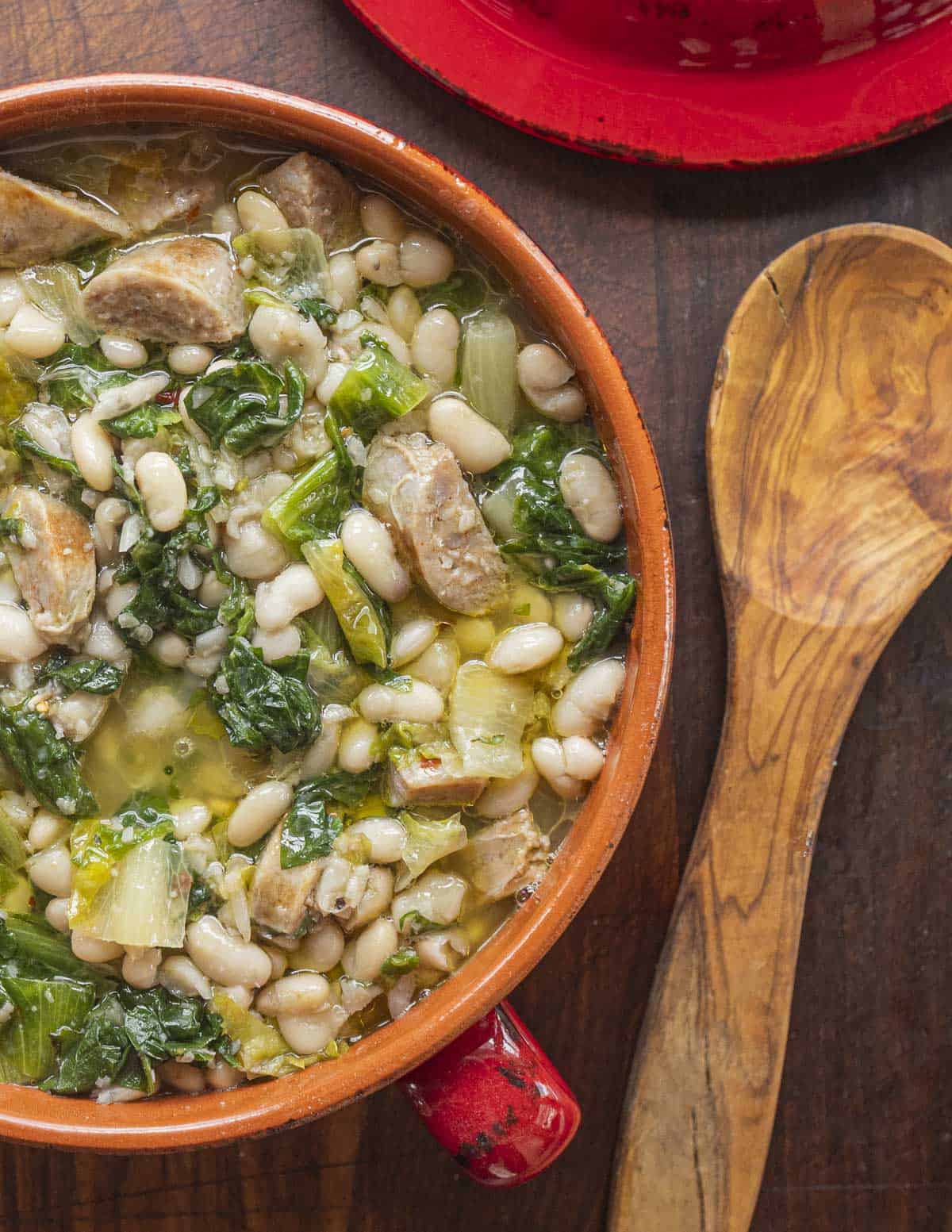
Not quite liquid enough to be a soup and too wet to be a sauté, braised escarole and beans is one of many Italian dishes you'll find relying on greens, vegetables and beans. Giambotta / Ciambotta is another great example.
I learned of the dish while working for Chef Lenny Russo. An Italian American chef from Hoboken, he's the former chef-owner of the 6-time James Beard Award nominated Heartland Restaurant in St. Paul, and a pioneer in the Midwestern farm to table movement.
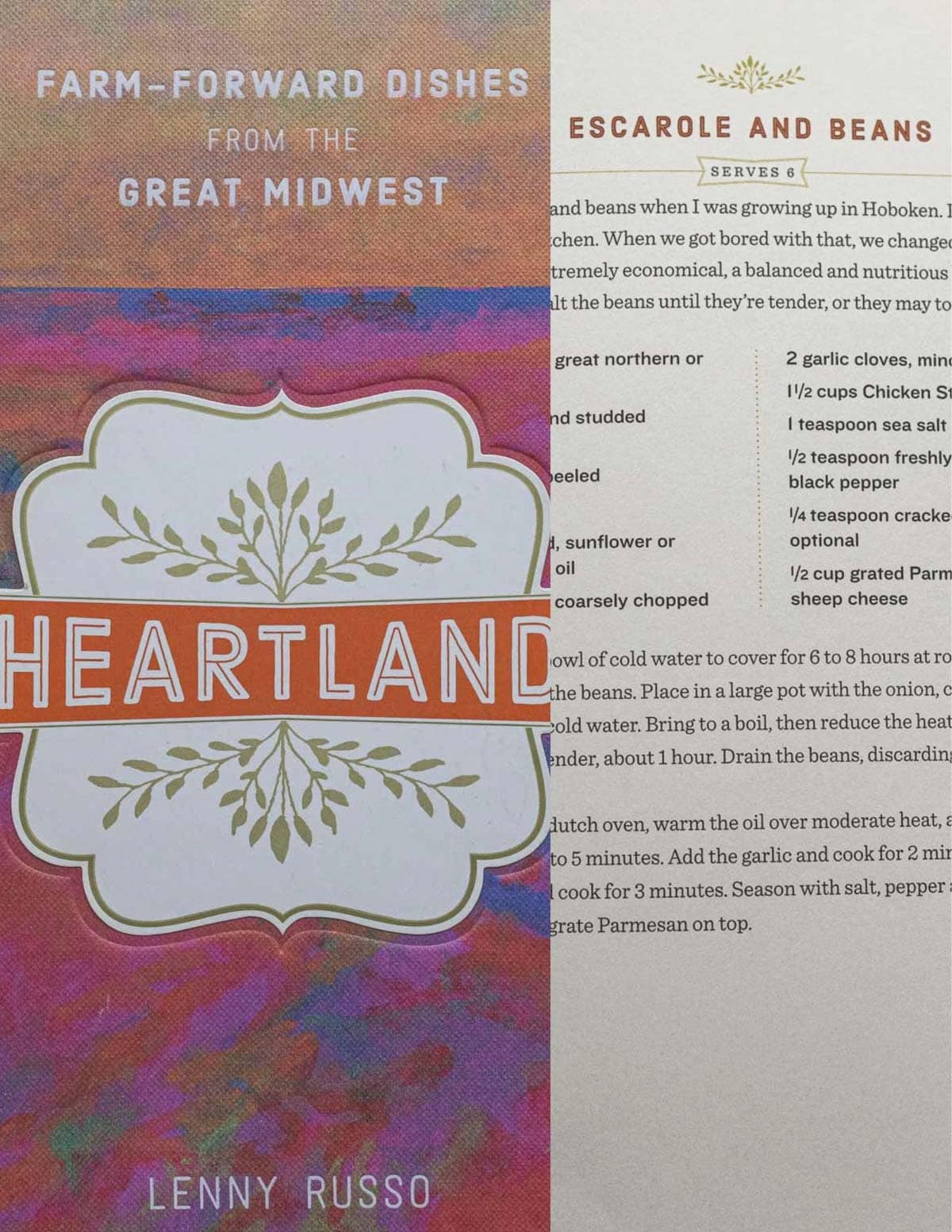
I spoke with Lenny over the holidays about the dish and, true to form, the saying I remembered hearing working on the line came up: "We didn't have a lot of money growing up so we ate a lot of escarole and beans. Sometimes we'd switch it up and have beans and escarole".
The recipe's in his book "Heartland: Farm-Forward Dishes from The Great Midwest". He's also passed the recipe onto others like Joe Yonan, a food editor for the Washington Post. Chef Russo's recipe is featured on the cover of Joe's book Cool Beans, shown below, with rapini substituted for the escarole.
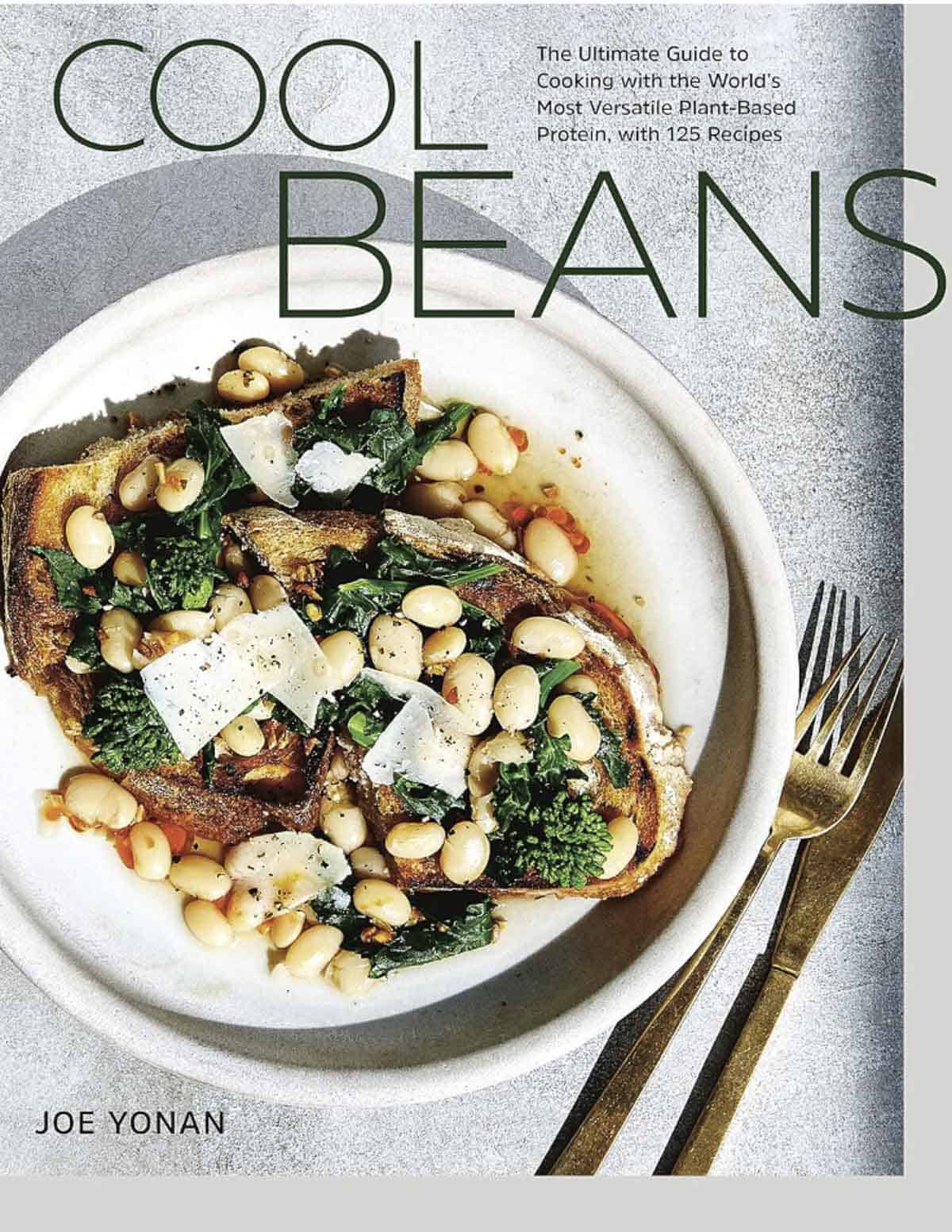
A Few Escarole Substitutes
If you're not familiar, escarole (Cichorium Endivia var Latifolium) is a type of leafy green in the chicory family often used in Italian wedding soup. It has a slightly bitter flavor but is more tame than dandelions or broccoli raab. But, unless you're in a large city or have an Italian grocer nearby it can be tricky to find escarole greens.
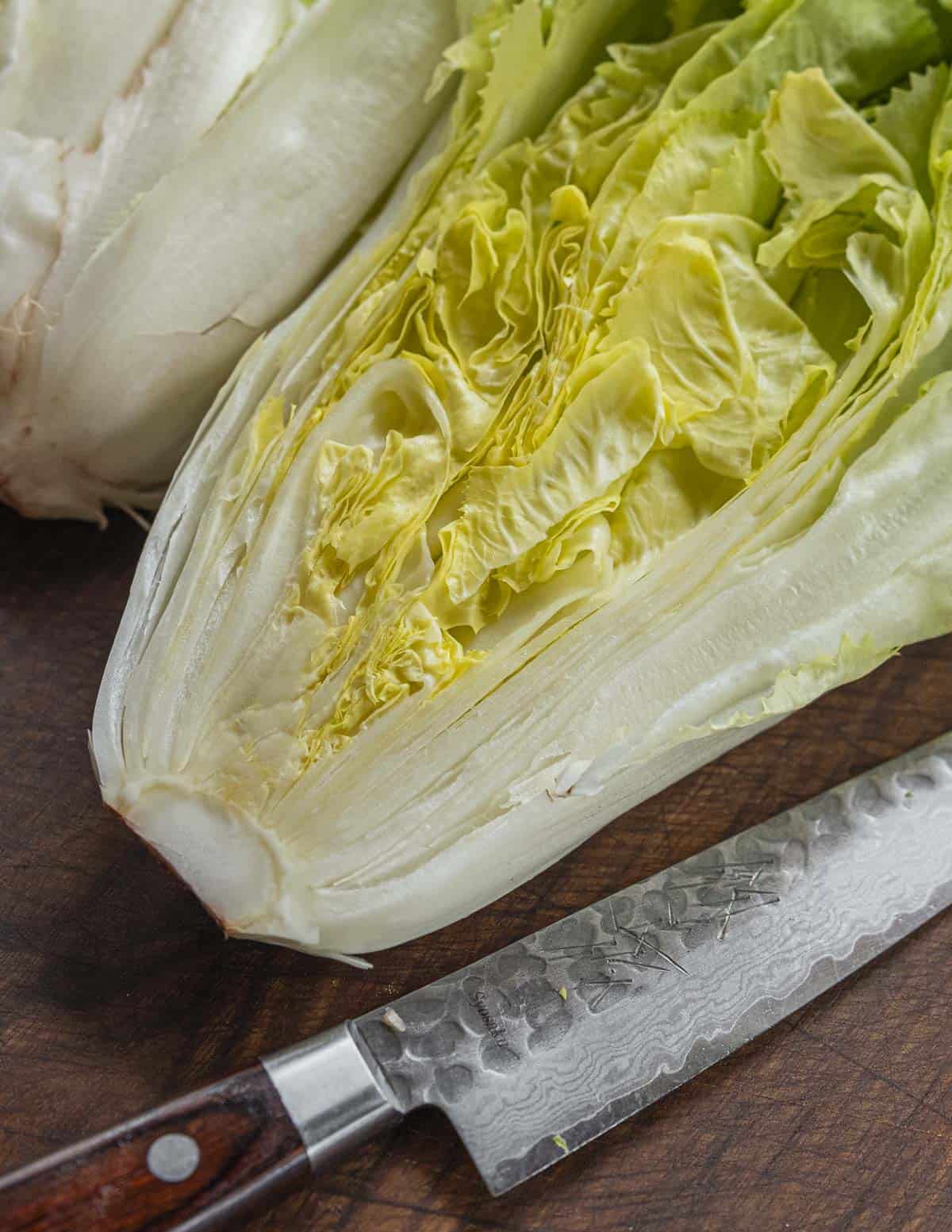
The good news is there's a number of leafy green vegetables that are great substitutes for escarole, although all of them have slightly different cooking times, tastes and textures. Mustard greens are probably the most widely available substitute, but I think rapini or chicory greens are the best. Here's a little background on the different greens you could use if escarole isn't available.
Rapini / Broccoli Raab
Much different than broccoli or broccolini, broccoli raab is more bitter than escarole, as well as more expensive. The stems also require longer cooking to be tender.
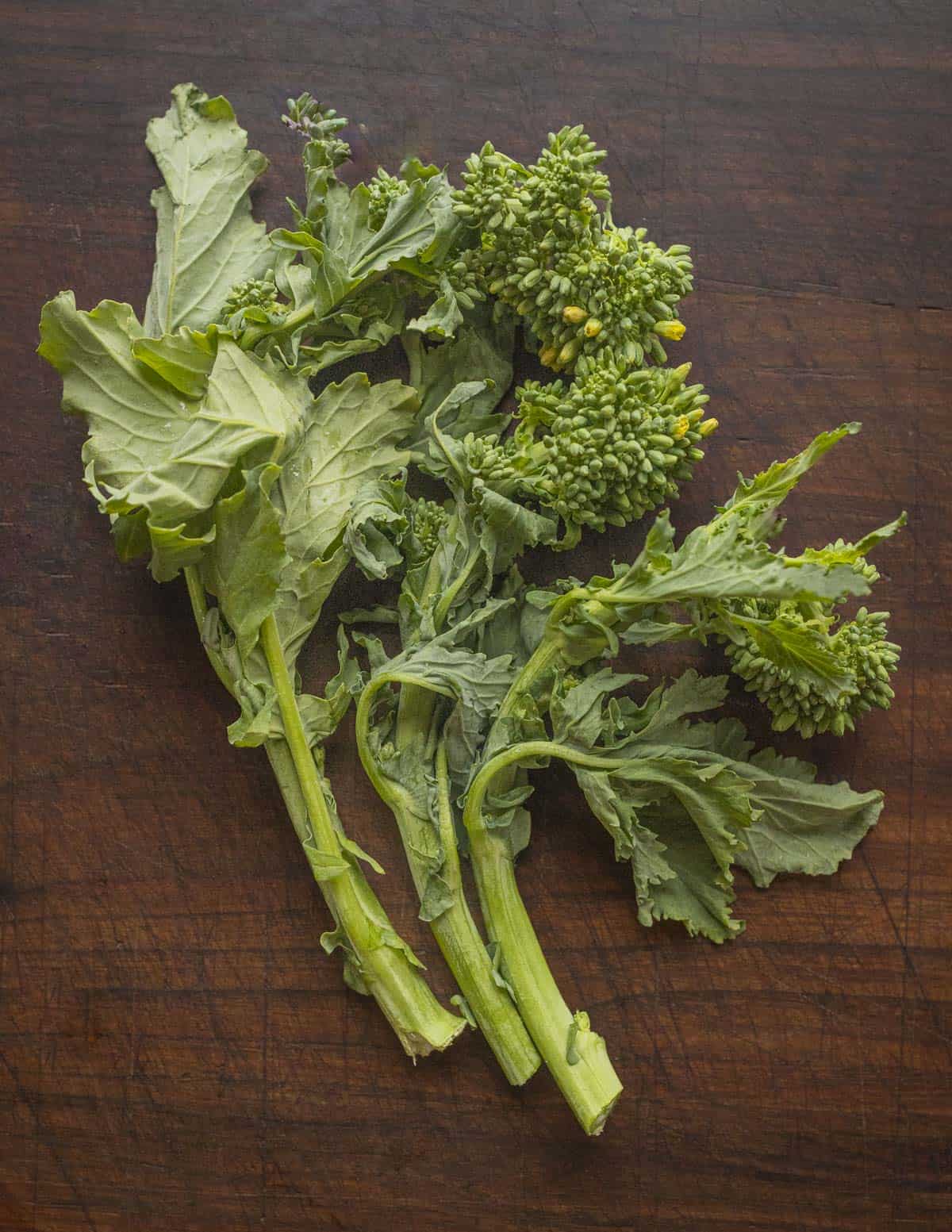
A quintessential Italian ingredient, besides cooking as a side dish it's traditionally used in orrechiette alla Barese and a number of other recipes.
Mustard Greens
Mustard greens have a comparable texture to escarole, but have a spicy Brassica flavor that mellows with cooking and very mild bitterness.
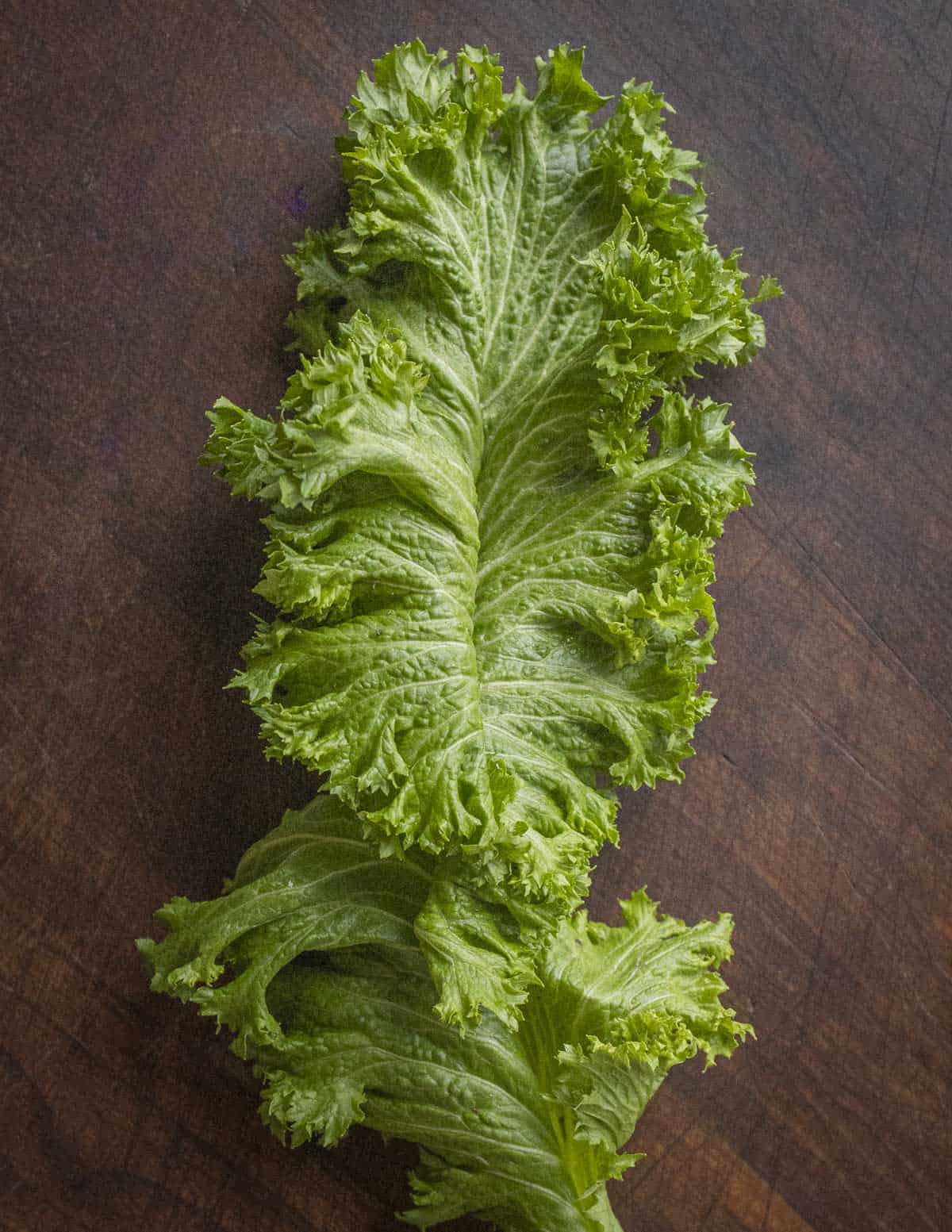
The stems take much longer to cook and should be removed for this dish, or cooked slowly until very tender before adding to the beans.
Dandelion Greens
Dandelions, wild and cultivated are good escarole substitutes as they're a close relative of escarole. Cultivated dandelions have much more leaf than stem and require less cooking time.
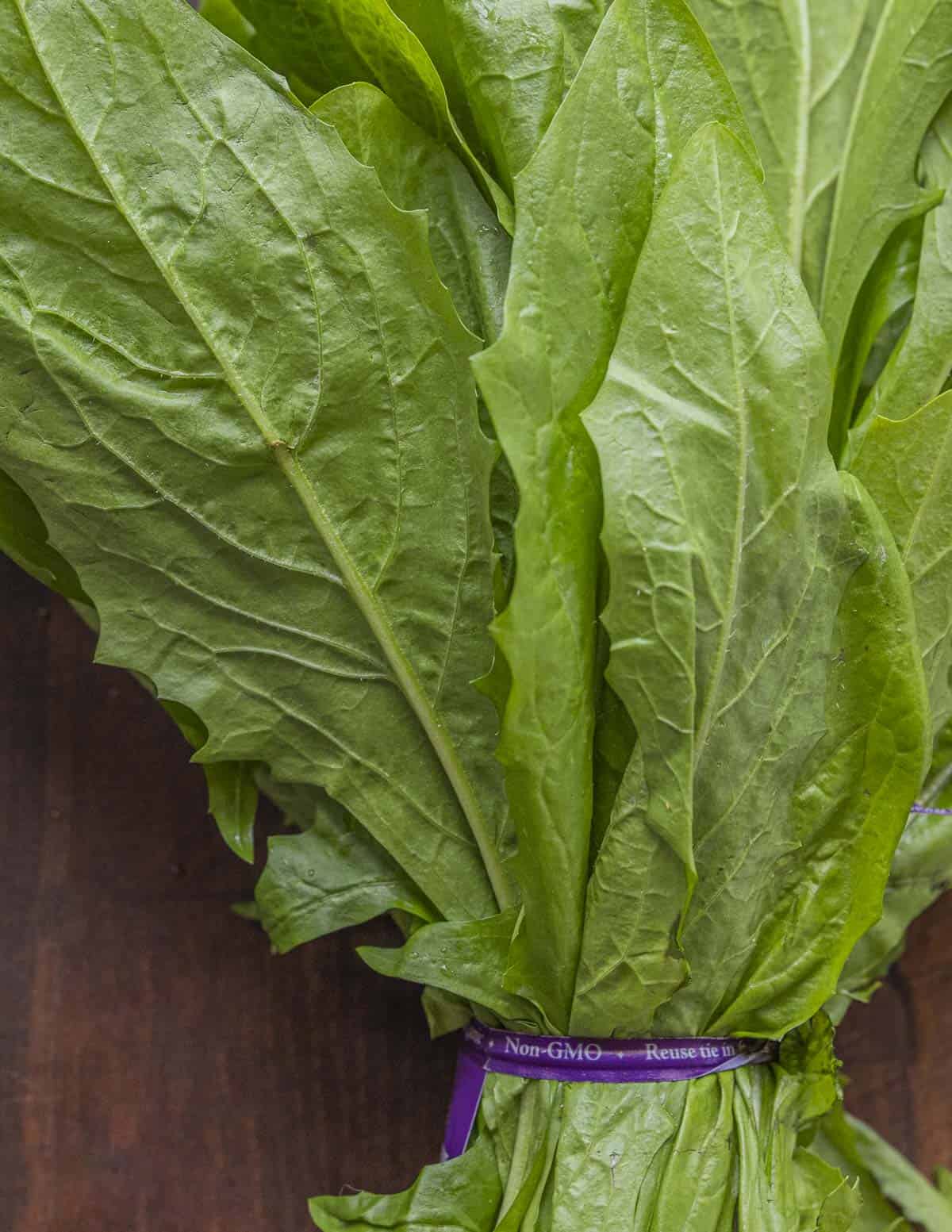
Wild dandelions (unless very young) have tougher stems that require extended cooking to be tender.
Chicory Greens
Escarole is a chicory, but not all chicories are escarole. Somewhere in between the bitterness of dandelions and escarole, fresh chicory greens (Chicorium intybus) are the most difficult of all the greens I've mentioned to come by, at least for me.
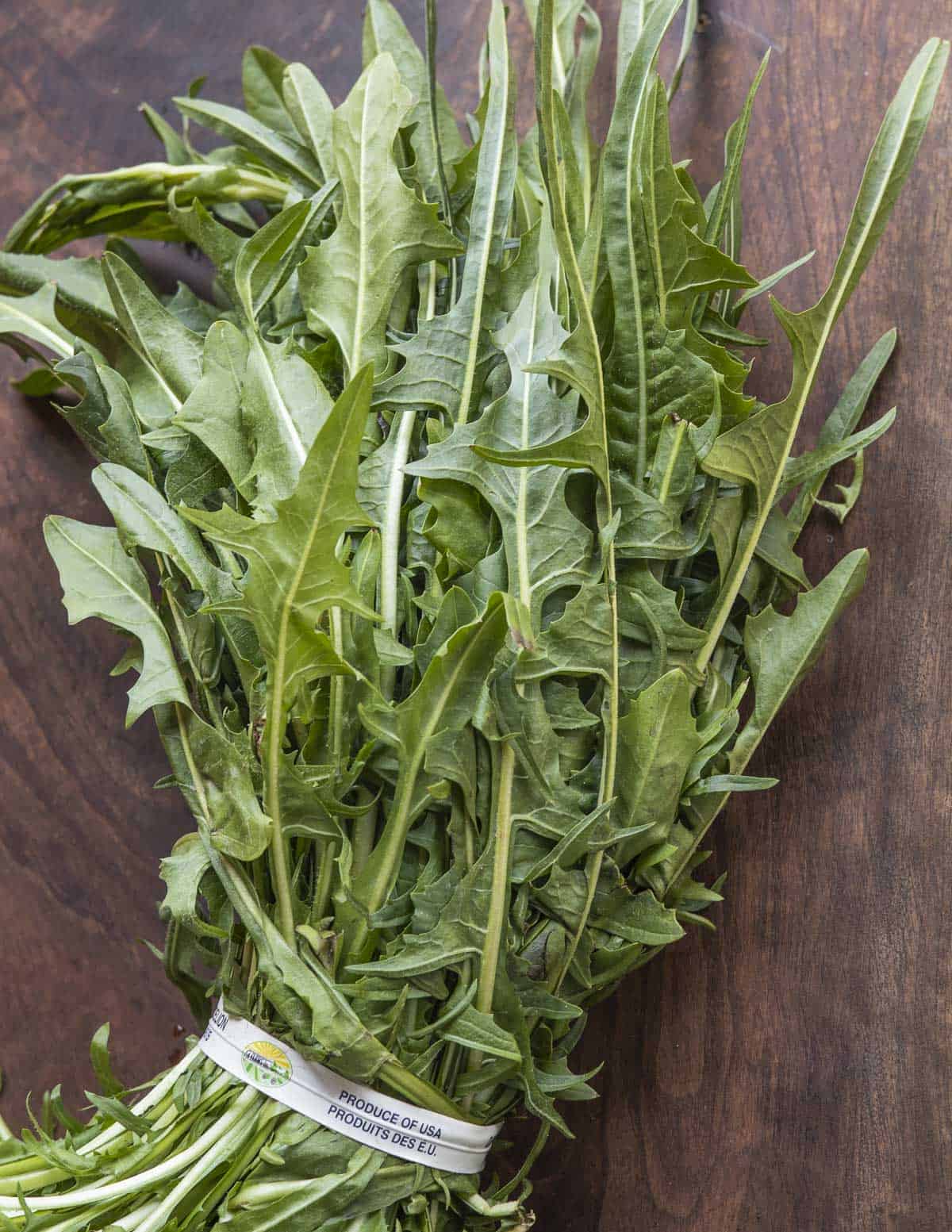
I occasionally see them at Middle Eastern grocers like Holy Land in Minneapolis as they're used to make things like Hindbeh.
How to Make Escarole and Beans
The first step is to soak the great northern / cannellini beans overnight. Although you can use canned white beans, cooking your own is an important step to building good flavor in the dish and is a good excuse to try your hand at using a clove-studded onion if you haven't before.
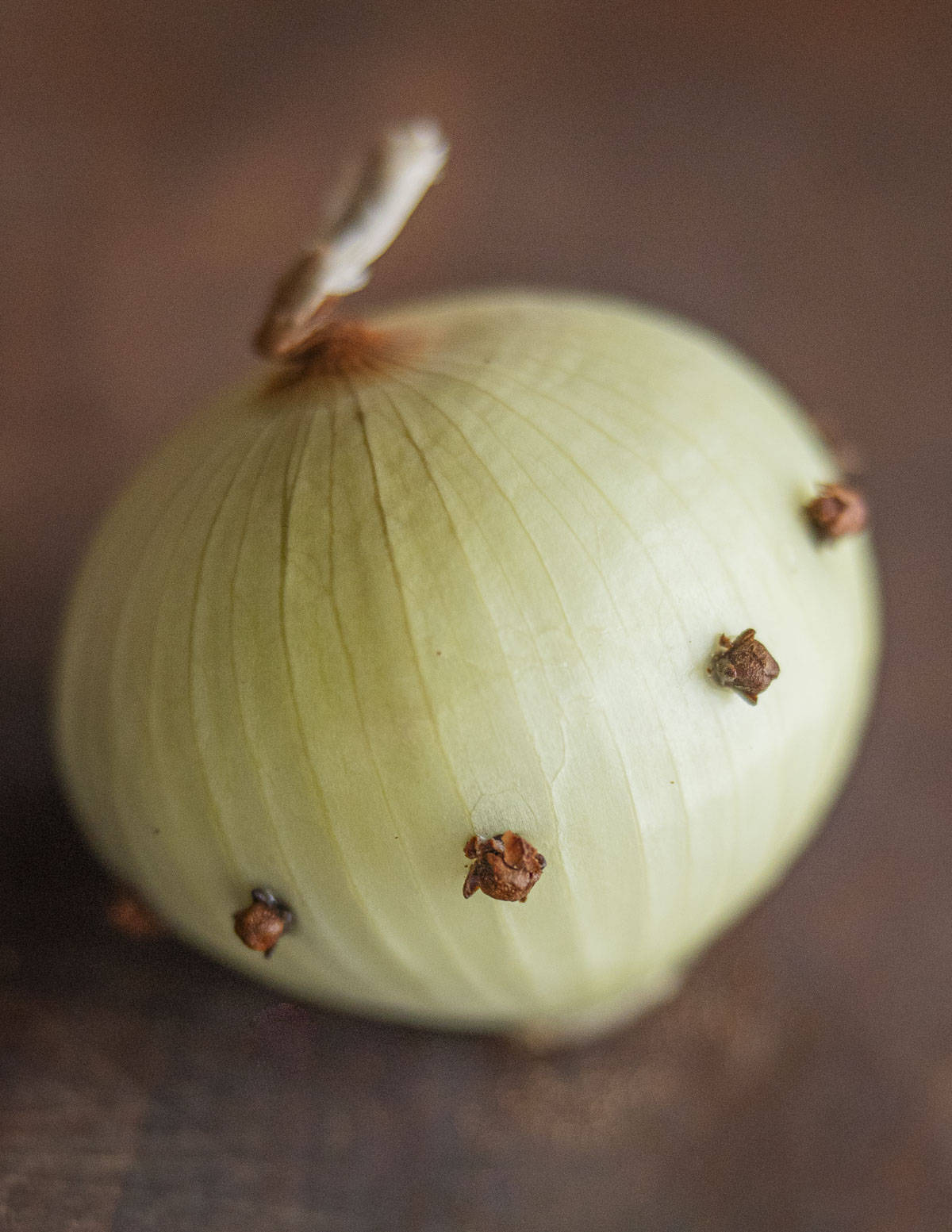
After soaking the beans are drained and simmered with a few peeled carrots, dried bay leaves, and the clove-studded onion until the beans are tender.
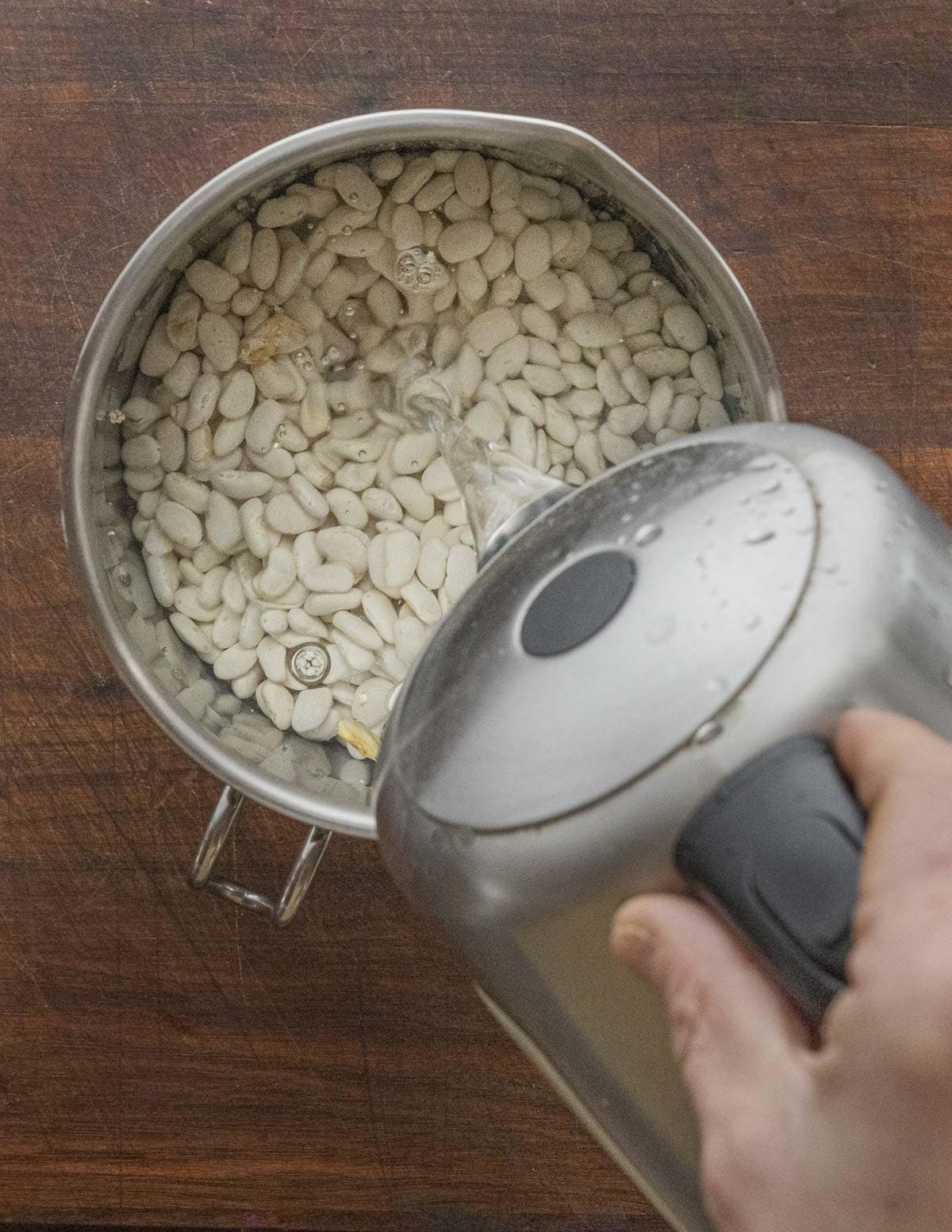
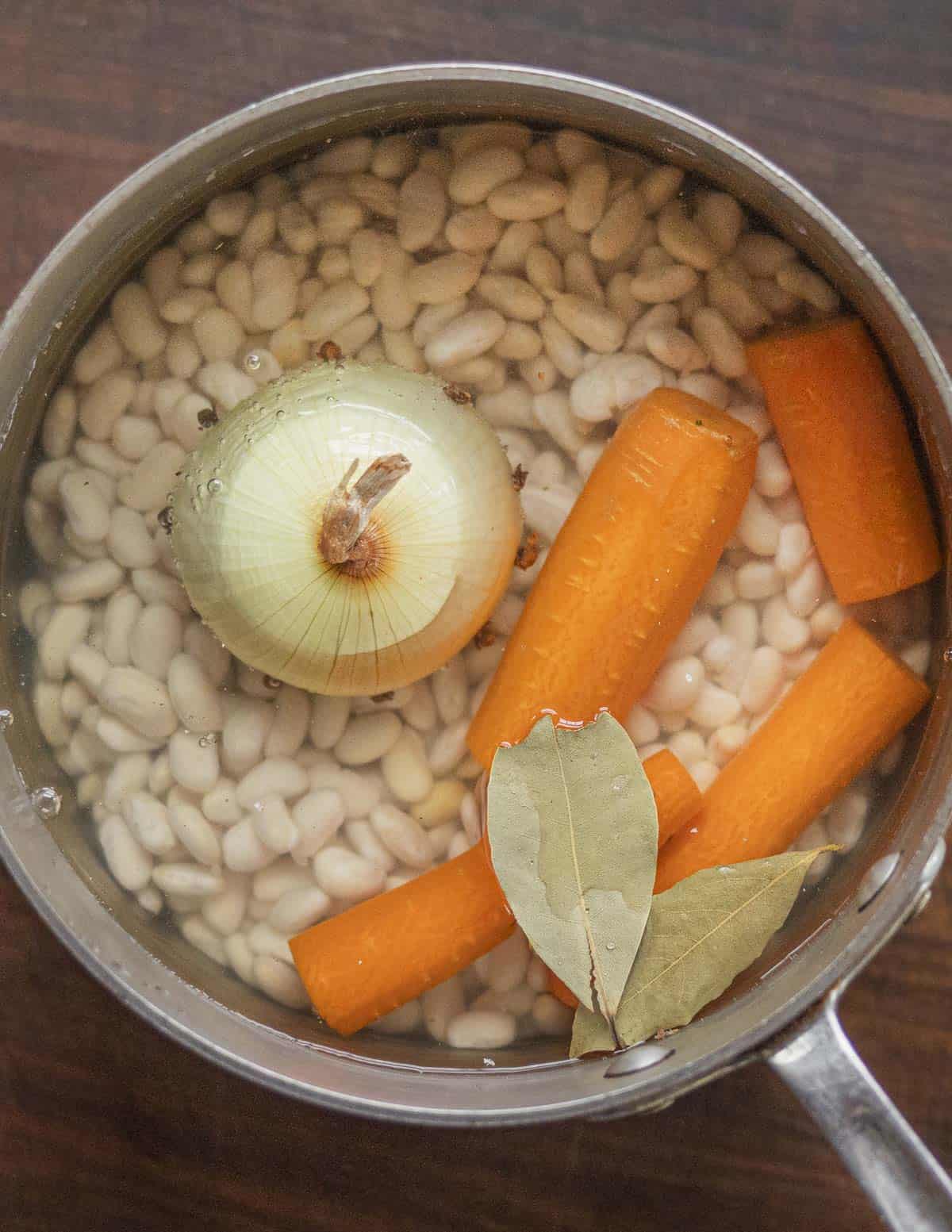
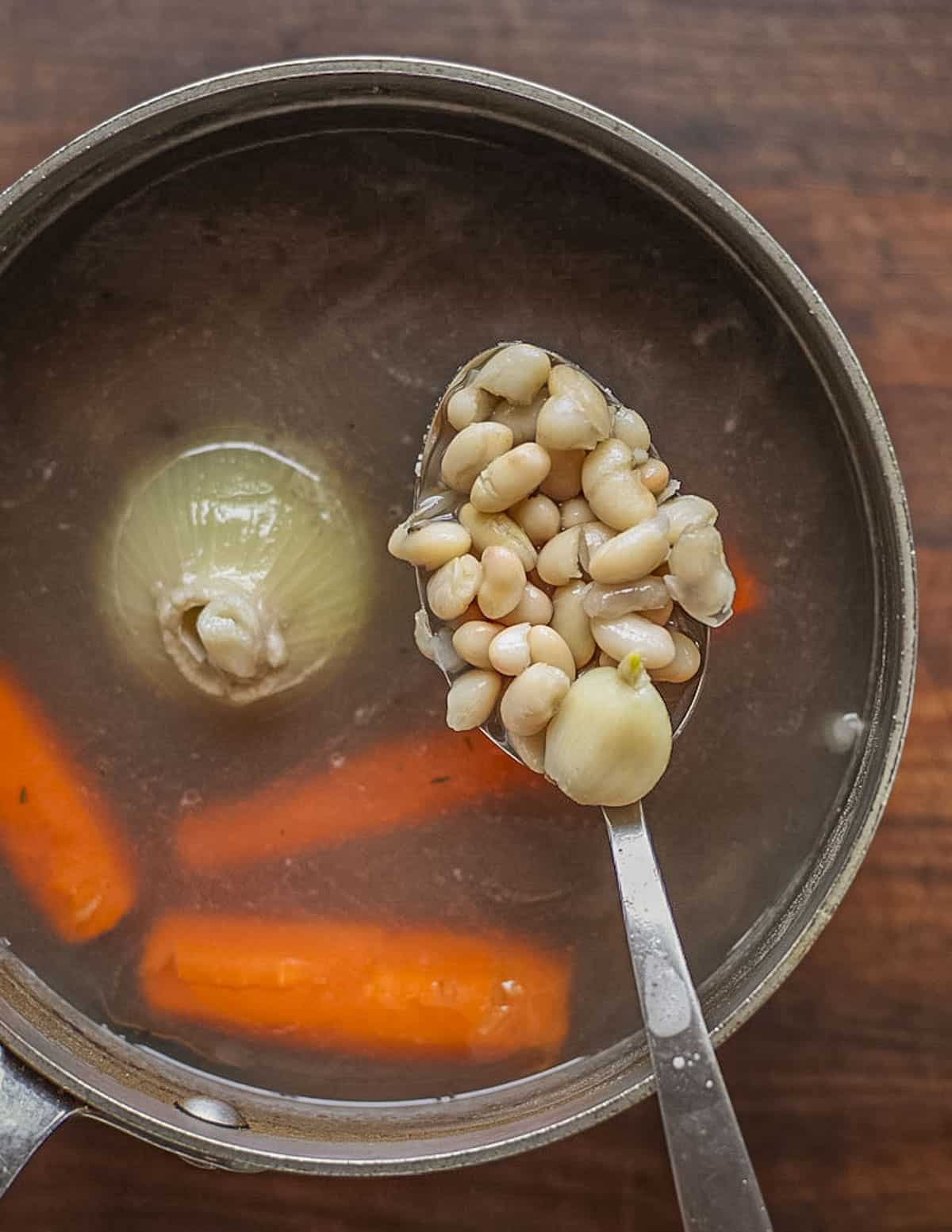
The only other prep to do before cooking the dish is to wash and dry the escarole and cut into 1 inch dice so the leaves fit on a spoon. I sliced a few roasted links of mild Italian fennel sausage to add to mine, but it's optional.
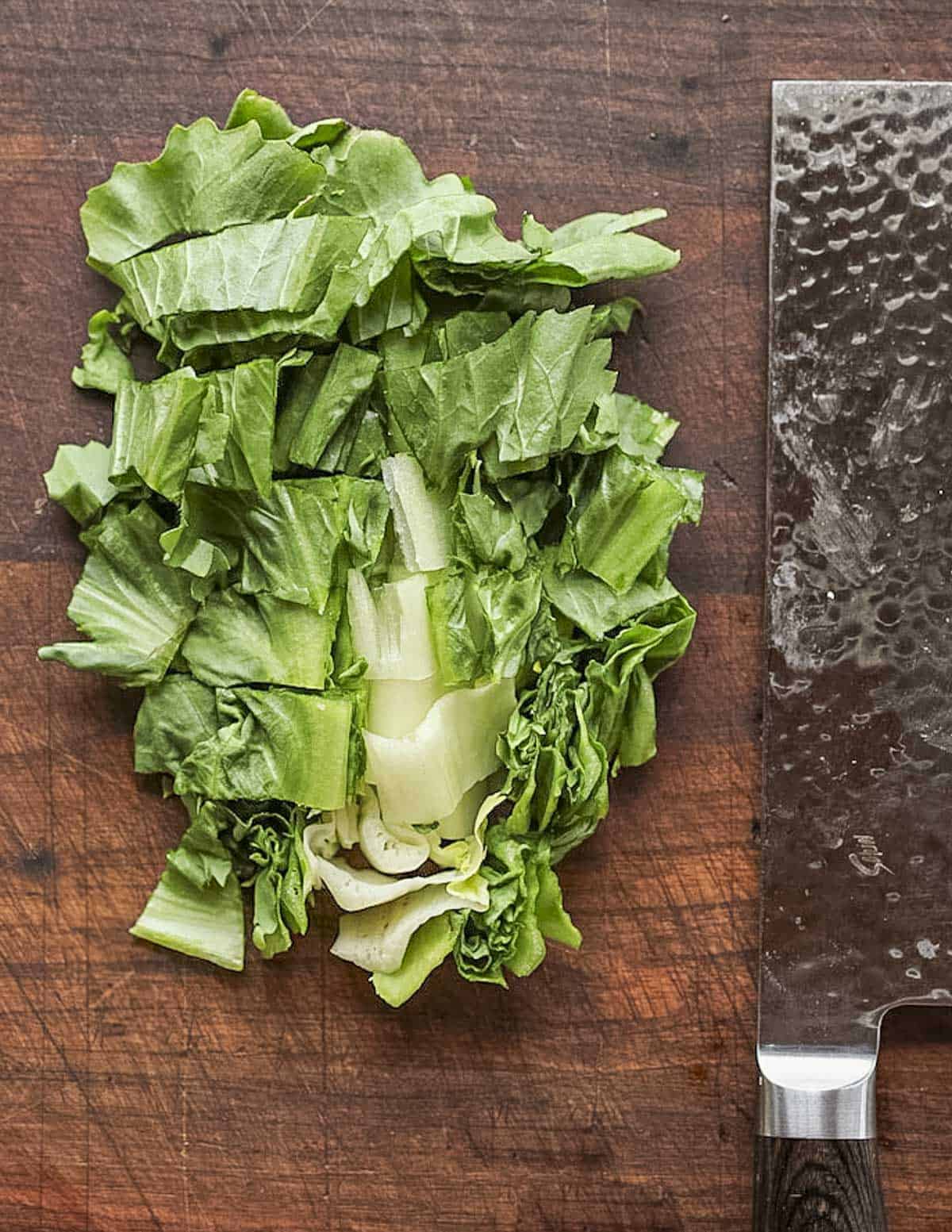

To cook the dish you start by sweating a large clove of minced garlic in a wide pan. I love my 10 inch sautoir pan for this. If you want to add sausage, you can brown ground sausage or links and cook the garlic in the drippings as I've done.
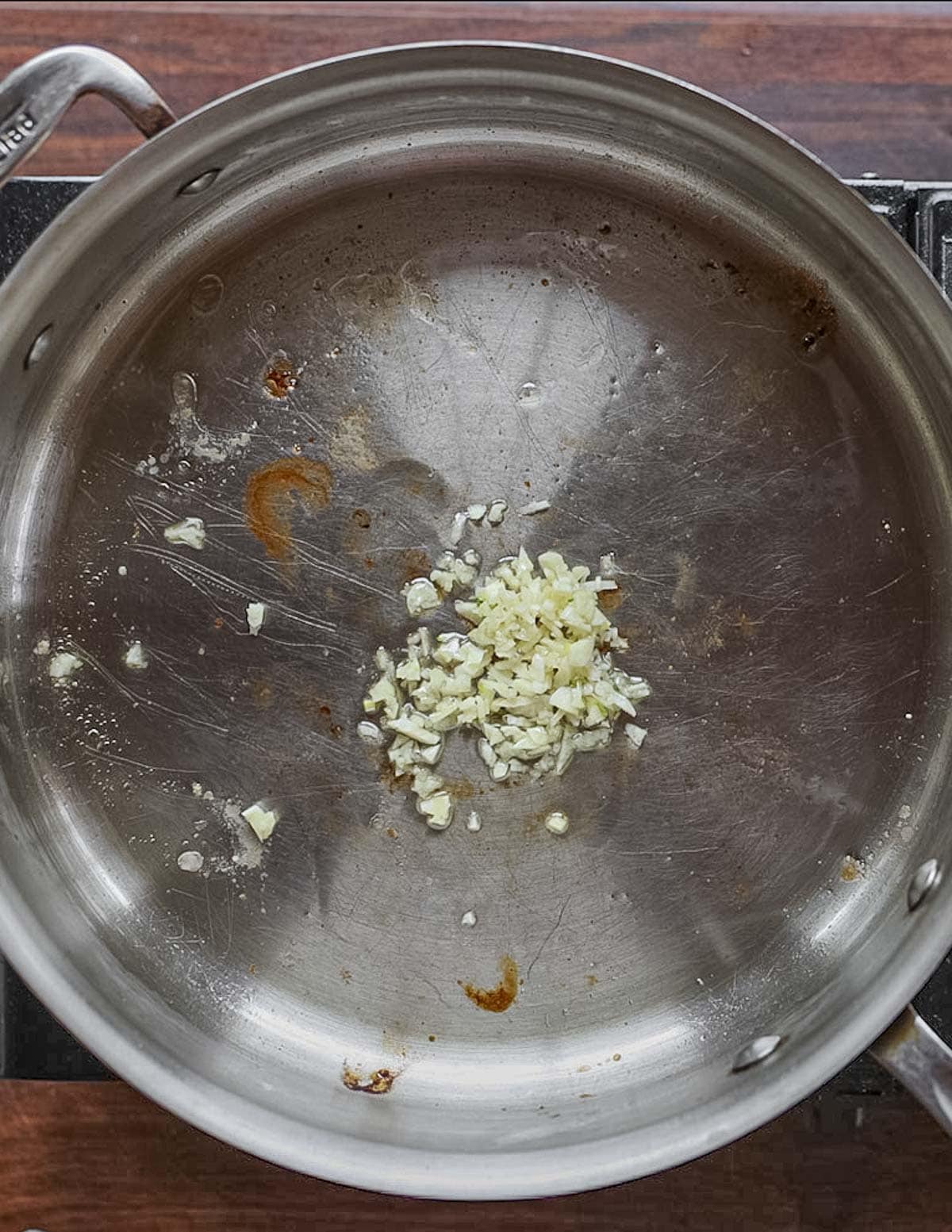
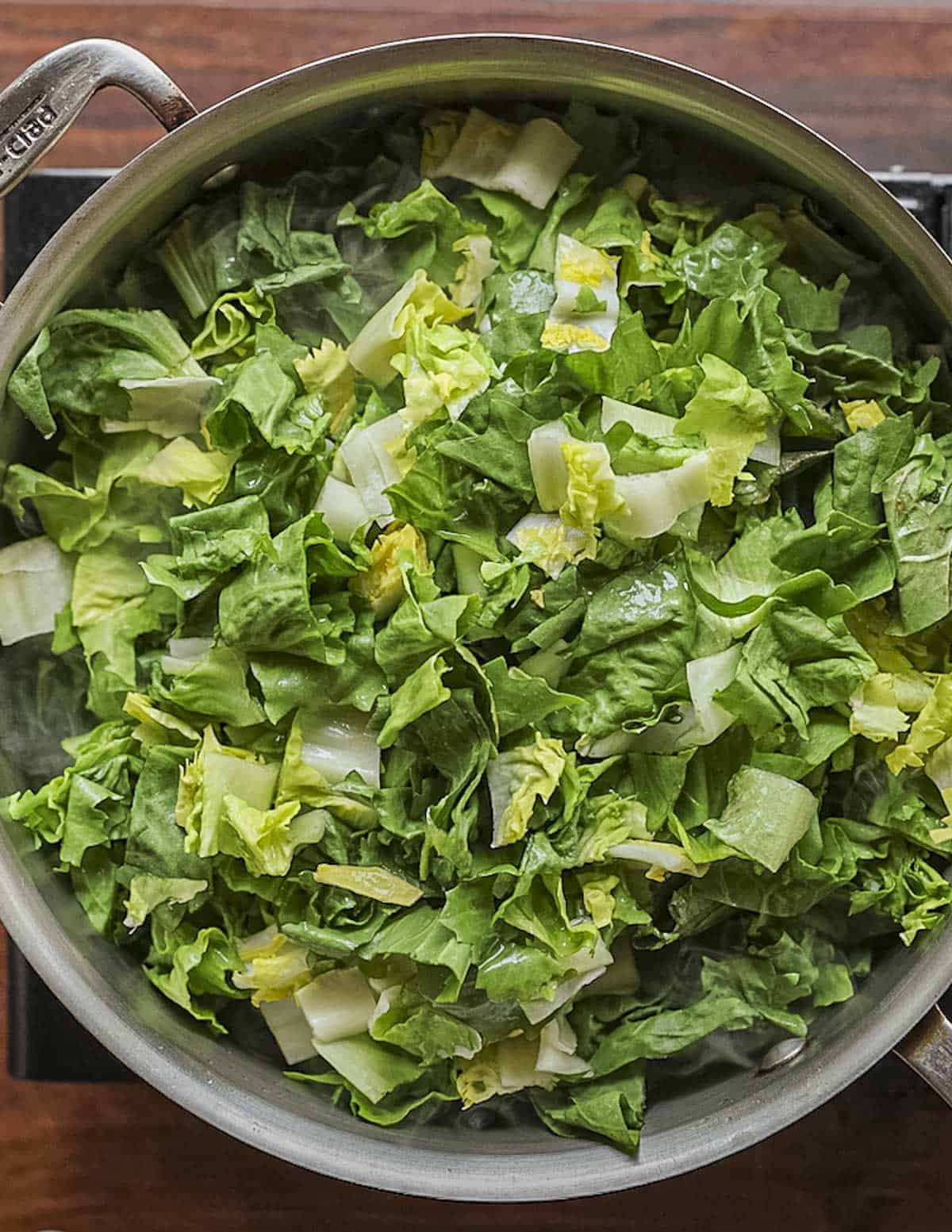
Once the escarole is wilted the beans and sausage (if using) are added, along with some homemade chicken stock and crushed red pepper flakes. While it can be tempting to add the bean cooking liquid, chicken stock will add a better flavor and keep the color bright.
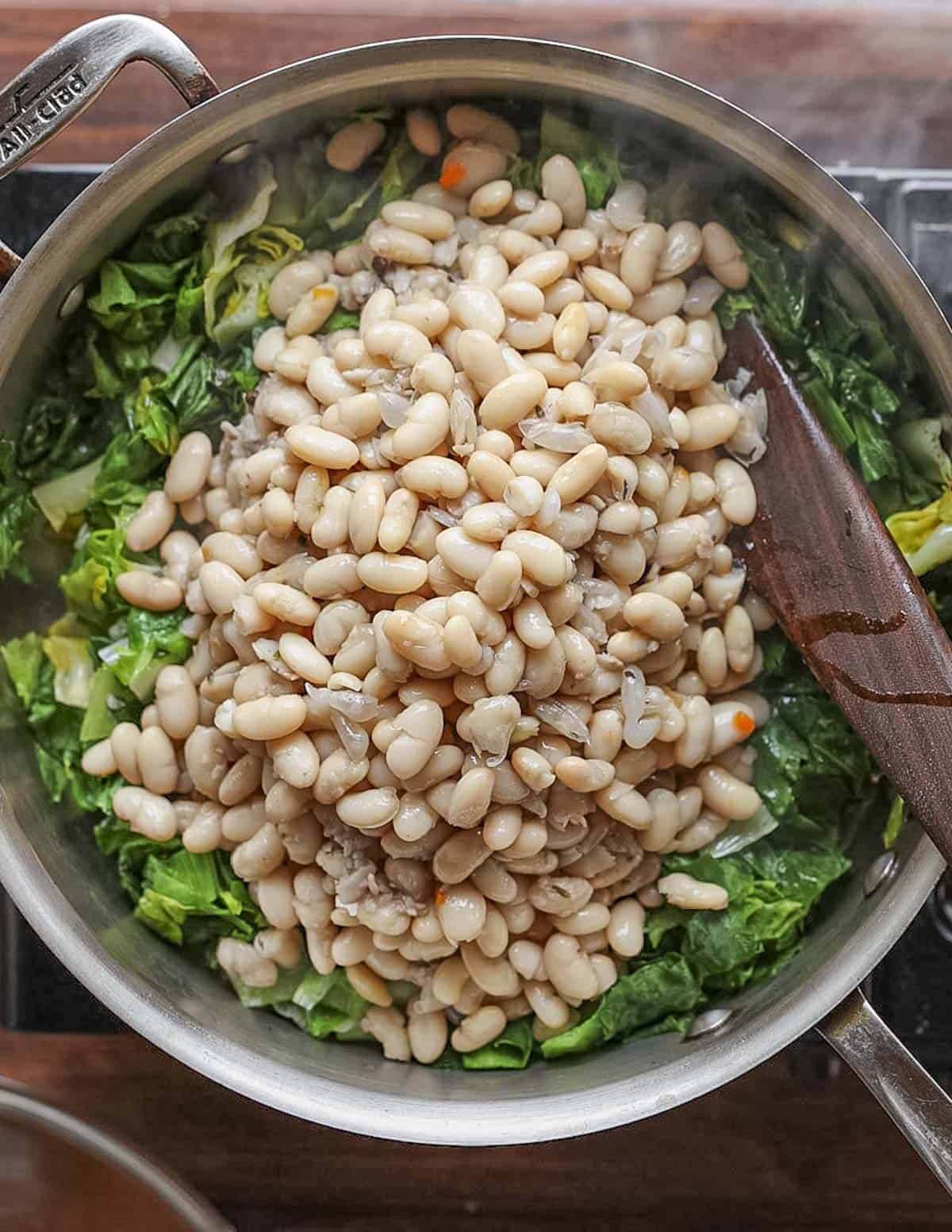
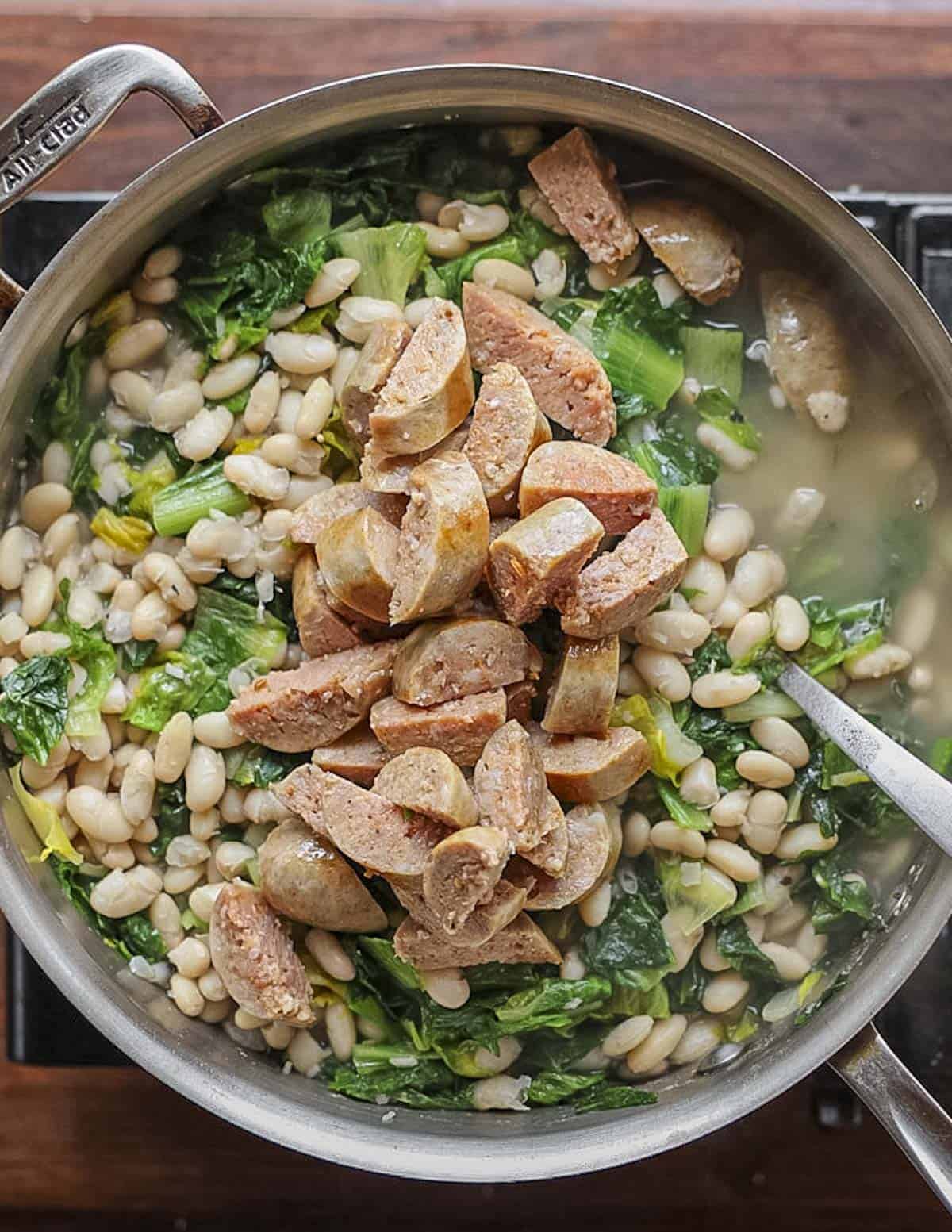
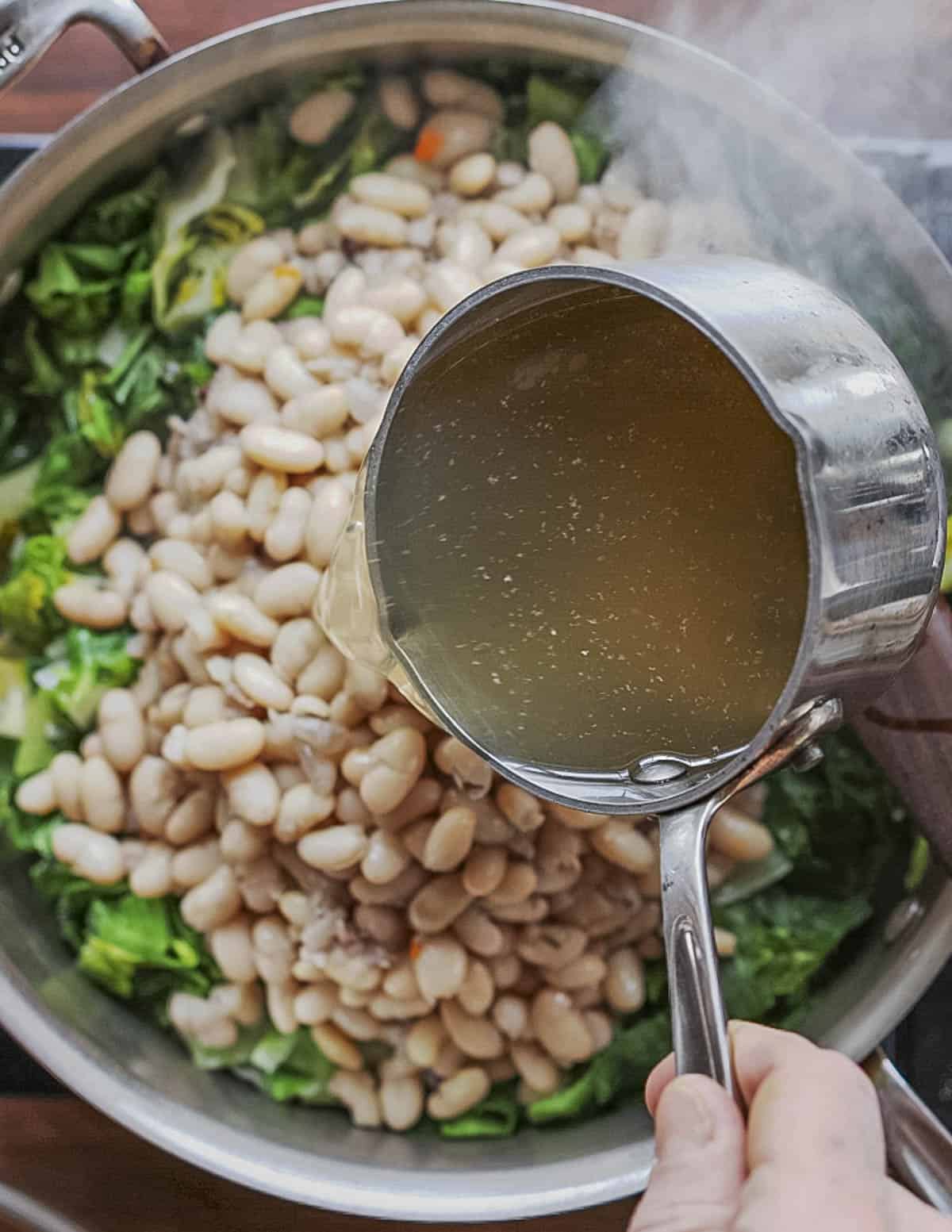
Simmer the pot gently until the greens are tender and taste good to you, then serve drizzled with a thread of extra virgin olive oil and freshly grated parmesan cheese at the table. Pecorino or aged sheep's milk cheese is my favorite if you can find some.
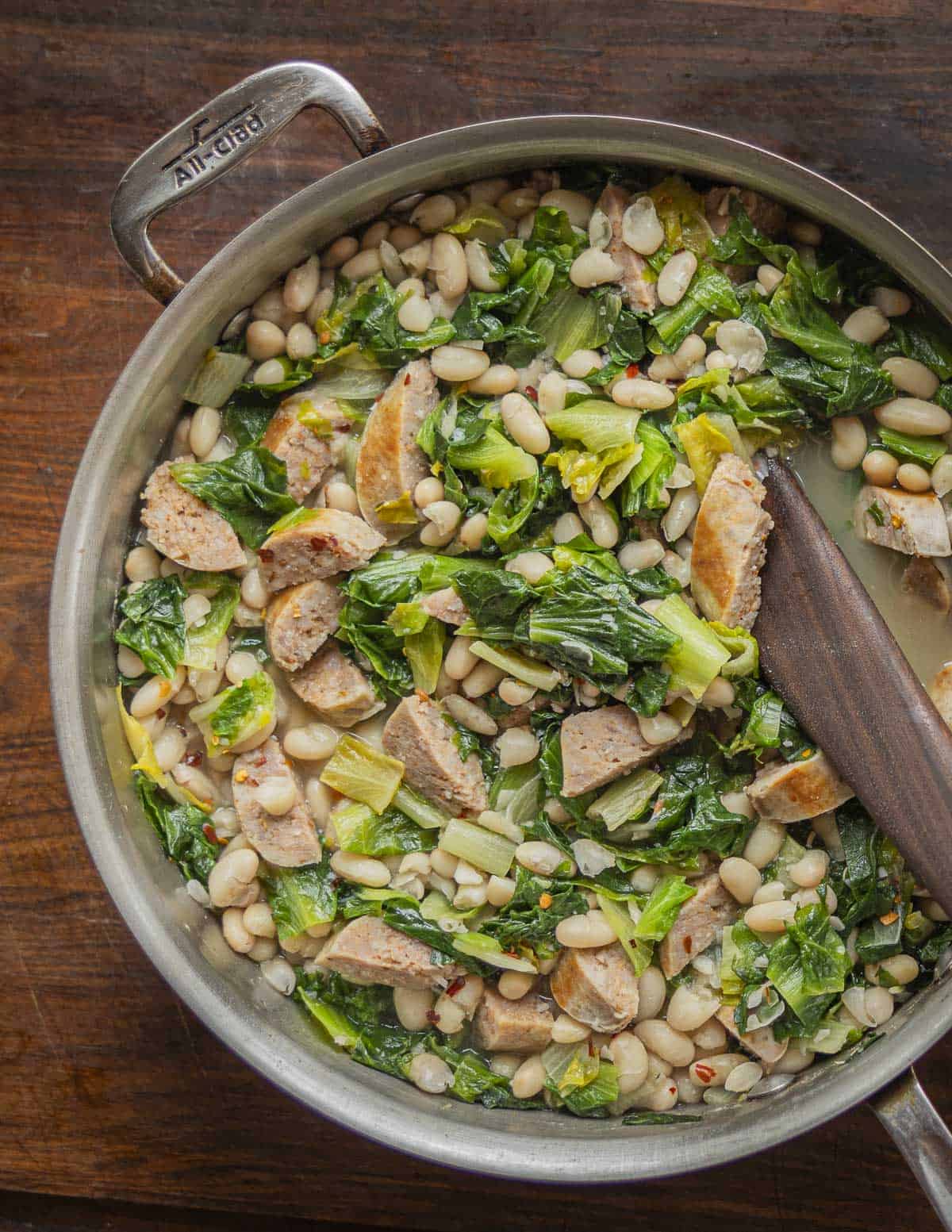
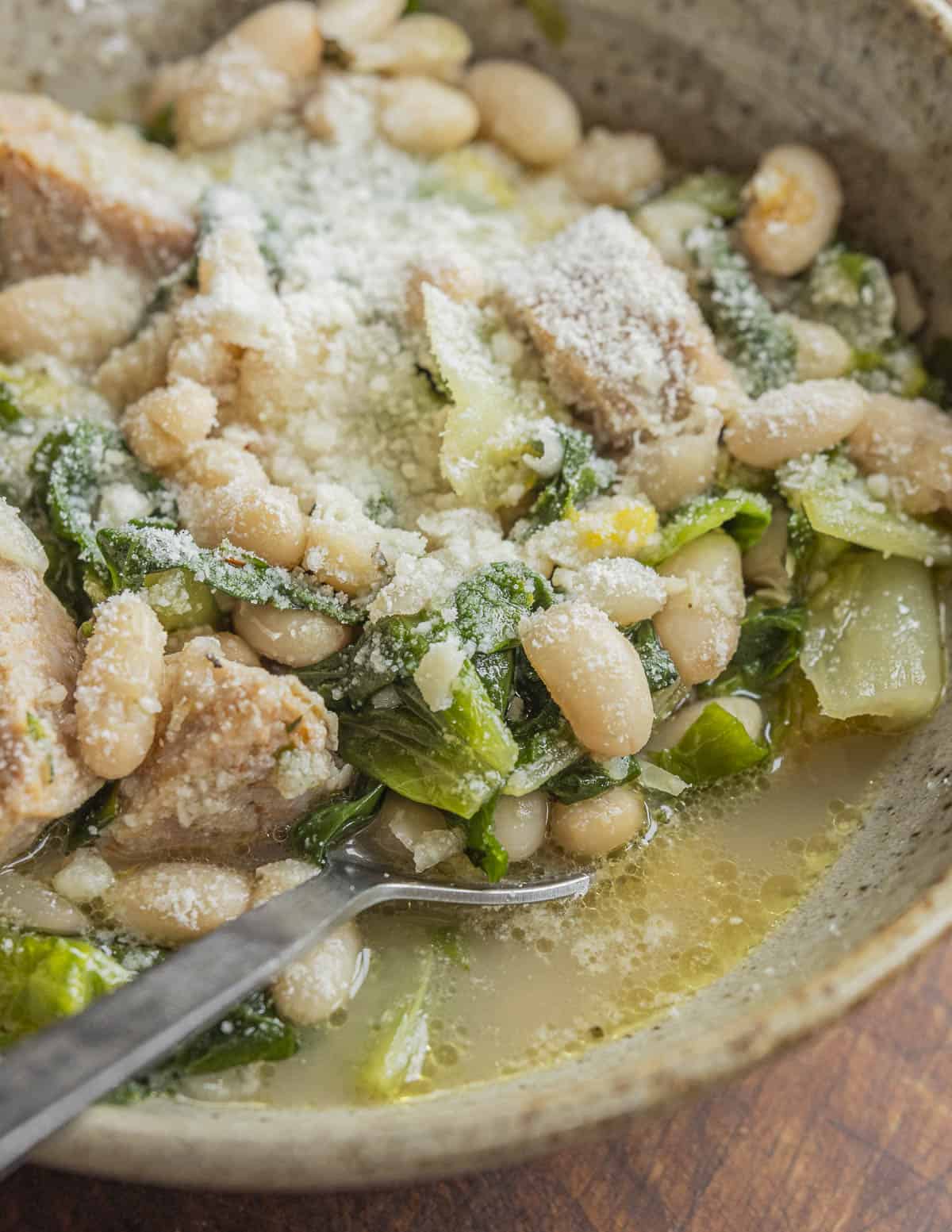
Variations
The dish is great all by itself but there's also plenty of different ways it can be adapted. If you add diced mirepoix before adding the garlic to the pan and increase the amount of chicken stock it makes a great soup.
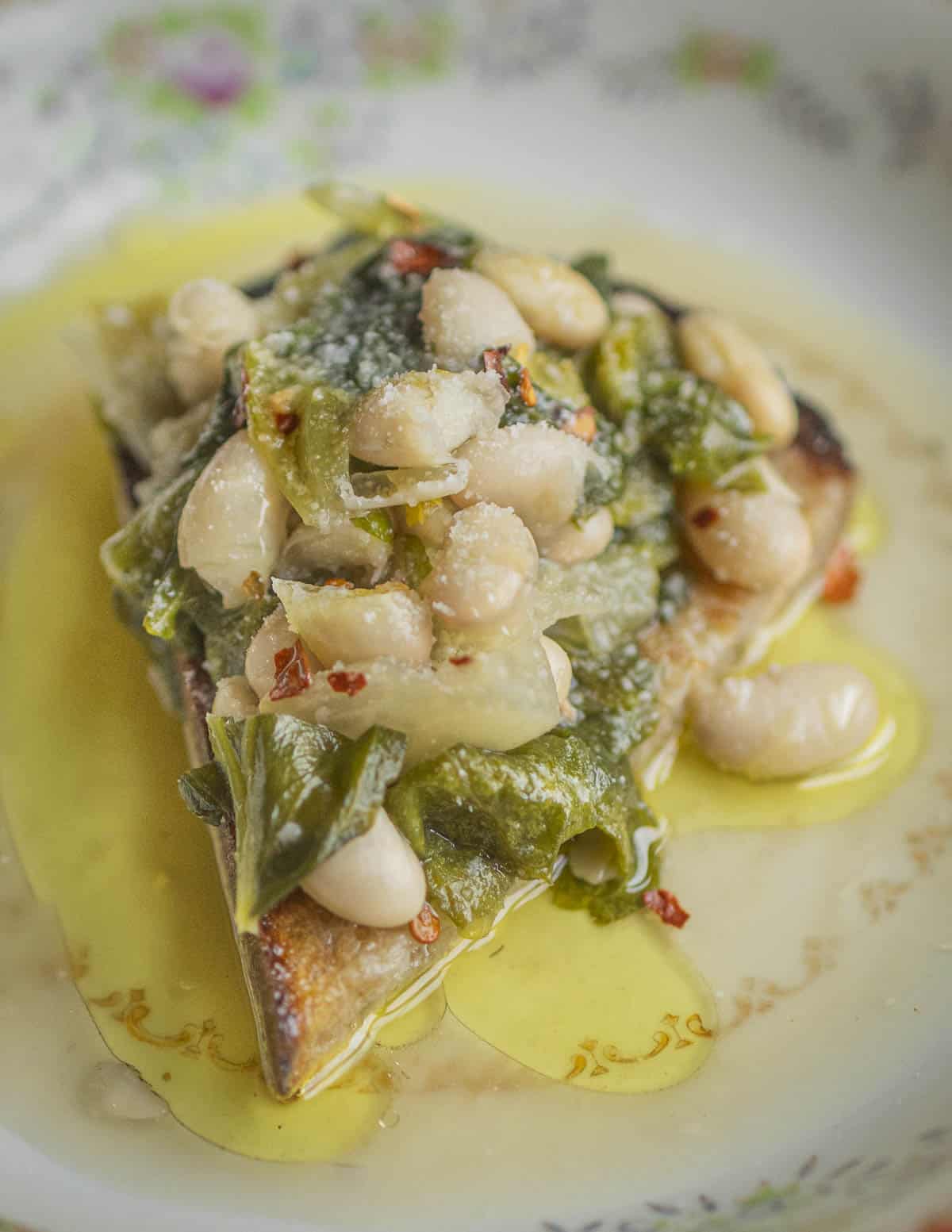
As pictured on the cover of Joe's book, it's also the perfect thing to serve with crusty Italian bread or a good slice of sourdough to mop up the juices. Anyway you serve it, it's a delicious, nutritious meal with lots of ways to adapt it to what you have on hand.
Related Posts
- Orrechiette alla Bares (Pasta with Broccoli Raab)
- Tuscan Stew of Many Greens: La Minestrella Gallicano
- Fave e Cicoria: Fava Bean Puree with Bitter Greens
Italian Braised Escarole and Beans with Sausage
Equipment
- 1 10 inch wide saute pan with high sides or a Dutch oven
- 1 wooden spoon
- 1 chefs knife
- 1 2 quart mixing bowl for soaking the beans
- 1 3-4 quart saucepot for cooking the beans
Ingredients
White Beans
- 12 oz (2 cups) Dried cannellini or great northern beans
- 2 Medium Carrots peeled and cut in half
- 1 Medium Yellow onion Studded with 10 cloves
- 2 Dried Bay leaves
- ½ Teaspoon Kosher salt
Braised Escarole and Beans
- 1 Large clove Garlic
- 2 TBSP Olive oil light olive oil
- 2 Cups Chicken stock preferably homemade
- 10 oz Escarole, cut into 1 inch pieces 1 large head *see note
- 12 oz Mild Italian Sausage roughly 3 large links, or use bulk sausage
- Fresh ground black pepper to taste
- Slices of toasted Italian bread or sourdough for serving, optional
Instructions
Beans
- Cover the beans with twice their volume of water and soak for 8 hours or overnight.
- Drain the beans and put them in a pot with the carrots, bay leaves, salt, garlic and clove-studded onion.
- Add water to cover the beans by a few inches, bring to a simmer and cook until tender. From here the beans can be made up to a few days ahead of time.
Escarole and Beans
- Trim the stem from the escarole and remove the leaves. Lay 2-3 leaves on top of each other and cut into 1 inch squares. Wash the escarole in cold water, spin dry or lay out on a towel and reserve.
- Preheat the oven to 400 F. Brown the sausage in a teaspoon of the oil, flip and bake in the oven until just cooked through (about 5 minutes). Remove the sausage to cool, then halve the long way and slice into ½ inch half-moons.
- Add the garlic and remaining oil to the pan and cook, stirring occasionally, until aromatic and no longer raw, without letting it brown (about 1-2 minutes).
- Add the escarole, stir to stop the garlic from over cooking and sweat for 2-3 minutes.
- Add the chicken broth, beans, sausage if using, and crushed red pepper flakes. Cover and simmer until the greens are tender and taste good to you (5-10 minutes).
- Serve the stewed greens and beans in warmed soup bowls garnished with fresh grated parmesan cheese, fresh cracked black pepper, extra virgin olive oil and a slice of crusty bread to mop up the juices.

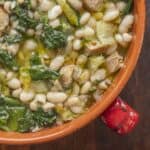
John M.
This one takes me back, and like others here, back to Western New York. In my case, Niagara Falls where I grew up. I’m a 65 year old Italian American and this was a staple in the homes for both sets of Italian grandparents. I also worked in a big Italian restaurant as a teenager and “beans and greens” was a popular lunch dish there.
And since this is my first comment on this site I want to join the chorus and thank you for it Alan. I took the WMS Mushroom Identifier Certification class here in Green Bay, WI last year. Several people in the class recommended the site and I think I’ve been here almost everyday since. I enjoy all of the foraging and cooking info, but I also love the way you tie it to traditional foods and recipes. I’ve cooked many things from here over the past year. So thank you for all of it. It’s a great site.
Flanman
Super fun - I happen to live in Rochester NY as well and "Greens and Beans" are a staple with a strong focus in Rochester and Syracuse. Most Italian restaurants here serve it stand alone, with bread, or over pasta. There is also a thing as you move east in Upstate NY called Utica Greens which is a different take on the whole thing and it involves breadcrumbs. This is something we've made many many times with some slight variations (mostly different types of greens like chard, cultivated mustard, wild mustard, turnip greens, kale, malabar spinach, dandelion greens, all from the garden, etc). My wife and I had a little lunch spot when we first started dating and they made REALLY good G&Bs but I could never get the owner to share the recipe. They've been closed now for over 20 years. There was a richness to theirs that I haven't been able to replicate. I also use my own organic chicken broth from the farm chickens my buddy gives me so it's a really good base.
As always, Thanks Alan! You are always putting out really good and interesting ideas and recipes that are compelling and unique .
Alan Bergo
Thanks Flanman.
Sara Wellman
I think part of the richness in restaurant food comes from using way more fat (in this case, olive oil) than I can bring myself to pour in.
I really miss the restaurants in Rochester, where the corner biker bar had great Italian food and wine!
Alan Bergo
I would say it typically comes from using enough salt. Lots of food is under-seasoned. This is a small amount of olive oil for a dish that will serve a whole family.
Christine
Hoboken! I had never heard of this chef but really enjoyed looking him up! You can get frozen versions of this in all the local supermarkets, it’s such a staple.
I really feel that midwest chefs do not get the credit they deserve. There’s just such a hype machine here, it’s so noisy, that I feel like it drowns out the less flashy food people in other parts of the country who do such quality work. I felt like the vibe here a decade or so ago was that southern cuisine didn't even really exist until NYC discovered it and I got in a little trouble for venting my opinion on that. But to do that level of work and get that many nominations and not win… oh well, I guess I’d prefer to be under-rated and estimated, than over.
Alan Bergo
Thanks Christie.
Mike Moranz
I split and dry lots of cherry tomatoes late summer and adding a handful is a tasty variation. I've been making this "steoup" for many years and it works with most any green and most any sausage. Artichokes work. Andouille and Cajun seasoning is excellent. I even occasionally throw in some pasta and sometimes a nice cornbread on the side.
Alan Bergo
Thanks Mike
Sara Wellman
I've been making this for decades, since I lived in Rochester NY in the 1980s. I use a lot more garlic and add a little hot pepper flakes. When I don't have escarole or chicory, I sometimes use kale or collards. I also use vegan sausage since I'm vegetarian. Great comfort food!
Alan Bergo
Thanks for sharing Sara.
Sara Wellman
I forgot to mention using garlic mustard!
Alan Bergo
Good idea.
AllisonK
I have made this dish many times (with or without the sausage)--it's easy and delicious! I have a 2 sq ft patch of chicory at the near end of my veg garden, planted from seeds (Eden Bros. or True Leaf Market?) several years ago. Chicory is a short-lived perennial (lives 3-7 yrs) and, while it reseeds, it's easy enough to keep my small patch under control. The leaves are absolutely delicious plus, every morning between mid-summer and frost, its beautiful blue flowers greet me as I'm headed to work.
In mid-summer, when the chicory is still coming up to speed (I live in NW Minn), I will supplement with some other tasty backyard greens such as dandelion, young sow/milk thistle, or lambsquarter. (I live in town and my neighbor is a "lawn fanatic", but my veg garden blocks most of their view of my wild backyard full of native plants, medicinal plants and forageables!)
Alan Bergo
Thanks Allison. I had a lot of fun cooking it again.